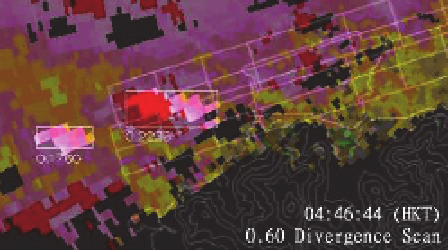Geoscience Reference
In-Depth Information
data along the glide path is given in Figure 8(b). At the location of the microburst, the F-
factor from the aircraft is comparable with that calculated from the TDWR data, even for
this case of terrain-disrupted airflow. As discussed in the first case study, the other
peaks/troughs of F-factor from the QAR data (Figure 8(b)) are not revealed in the TDWR
measurements. They may not be properly handled by the microburst model for F-factor
calculation.
Fig. 8. (a) Divergence features (highlighted in lighter colours) associated with windshear in
terrain-disrupted airflow on 3 August 2006, overlaid on the radial velocity from the TDWR
(colour scale given in Figure 6). F-factor of each feature is given as a number next to the box
indicating the location of the feature. (b) F-factor as recorded on an aircraft flying at about
the same time as in (a) along the glide path shown as a blue arrow in (a). The red arrow in
(b) is the approximate location of the windshear feature encountered by the aircraft.
4. Calculation of turbulence intensity
The measurement of spectrum width is determined not only by the Doppler velocity
distribution and density distribution of the scatterers within the resolution volume, but
also radar observation parameters like beamwidth, pulse width, antenna rotation rate, etc.
According to Doviak and Zrnic (2006), there are five major spectral broadening
mechanisms that contribute to the spectrum width measurements, which can be written as
follow
2
2
2
2
2
2
(6)
v
s
t
d
o
where
s
represents mean wind shear contribution,
t
represents turbulence,
represents
antenna motion,
d
represents different terminal velocities of hydrometeors of different
sizes, and
o
represents variations of orientations and vibrations of hydrometeors. Except
s
and
t,
the rest of the terms on the right hand side of the Eq.(6) are considered to be
negligible for the measurements of
v
in this paper (Brewster and Zrnic, 1986). Thus the
turbulence term
s
can be obtained,
t
2
v
2
-
s
2
.
(7)
In the Eq.(7), mean wind shear width term
s
can be decomposed into three terms due to
mean radial velocity shear at three orthogonal directions in radar coordinate(Doviak and
Zrnic, 2006):




